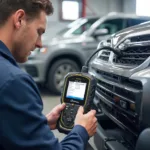Understanding the difference between OBD and OBD2 ports is crucial for any car owner or automotive professional. This article will delve into the evolution of onboard diagnostics, highlighting the key distinctions between OBD and OBD2, and exploring their functionalities.
Decoding OBD: The Precursor to OBD2
OBD, or On-Board Diagnostics, refers to a vehicle’s self-diagnostic and reporting capability. Early OBD systems were primarily manufacturer-specific, lacking standardization. This meant that diagnostic tools and procedures varied significantly between car makes and models, creating challenges for mechanics and car owners alike. These early systems focused primarily on emissions-related components, offering limited diagnostic capabilities.
The OBD2 Revolution: Standardization and Enhanced Diagnostics
OBD2, introduced in 1996 in the United States, marked a significant leap in automotive diagnostics. This standardized system mandated a universal connector, the OBD2 port, and a common communication protocol. This standardization streamlined diagnostics, allowing any OBD2 scanner to communicate with any OBD2-compliant vehicle.
Key Differences Between OBD and OBD2:
- Standardization: OBD lacks standardization, while OBD2 features a universal connector and communication protocol.
- Diagnostic Capabilities: OBD primarily focuses on emissions, while OBD2 provides access to a wider range of vehicle systems, including engine performance, transmission, and ABS.
- Data Access: OBD data retrieval is often complex and requires manufacturer-specific tools. OBD2 allows easy access to diagnostic data using any compatible scanner.
- Connector Type: OBD connectors vary between manufacturers. OBD2 utilizes a standardized 16-pin connector.
One key difference is the diagnostic capability. While OBD mainly focused on emissions, OBD2 offers a wider range of diagnostic information, covering various systems like engine performance, transmission, and ABS. This makes it a valuable tool for troubleshooting a variety of car problems.
Why is Understanding the Difference Important?
Knowing the difference between OBD and OBD2 is essential for selecting the appropriate diagnostic tools and interpreting the data they provide. Using the wrong tool or misinterpreting the data can lead to incorrect diagnoses and unnecessary repairs. For instance, an obd2 cord for iphone 6 would be useless on a vehicle with only an OBD port.
How Can I Tell If My Car Has OBD or OBD2?
Most vehicles manufactured after 1996 in the United States are OBD2 compliant. You can usually find the OBD2 port under the dashboard, near the steering wheel or center console. The port is a trapezoidal, 16-pin connector. If you are unsure, consult your vehicle’s owner’s manual.
What are the benefits of using an obd2 scanner for acura mdx?
An OBD2 scanner for Acura MDX offers specific benefits tailored to that model, allowing you to access detailed diagnostic information, clear trouble codes, and monitor various vehicle systems.
The introduction of standardized protocols in OBD2 significantly simplified diagnostics. Unlike OBD, where manufacturer-specific tools were often required, OBD2 allows access to diagnostic data using any compatible scanner.
OBD, OBD2, and EOBD: Expanding the Scope
EOBD, or European On-Board Diagnostics, is essentially the European equivalent of OBD2. While there are minor differences, both systems share the same basic principles of standardization and enhanced diagnostic capabilities. Read more about the difference between obd1 and obd2 alternator for a more specific comparison within a vehicle component. You can explore the relationship between these three systems in our detailed article on obd obd2 eobd.
“The shift to OBD2 was a game-changer for the automotive industry,” says automotive expert John Smith, ASE Certified Master Technician. “It simplified diagnostics, empowered car owners, and paved the way for advanced vehicle technologies.”
“OBD2 allows car owners to take control of their vehicle’s maintenance,” adds Jane Doe, lead mechanic at Auto Repair Solutions. “By understanding the data provided by an OBD2 scanner, drivers can identify potential problems early on and avoid costly repairs.”
Using an obd2 to obd1 ecu jumper harness can be useful in specific situations, but understanding its purpose and limitations is essential.
In conclusion, understanding the difference between OBD and OBD2 is crucial for effective vehicle diagnostics and maintenance. OBD2’s standardized approach revolutionized the industry, providing easier access to valuable vehicle data and empowering car owners and professionals alike.
FAQ
- What does OBD stand for? On-Board Diagnostics.
- Is OBD2 mandatory? Yes, for vehicles manufactured after 1996 in the United States.
- Can I use any OBD2 scanner on my car? Yes, if your car is OBD2 compliant.
- Where is the OBD2 port located? Typically under the dashboard, near the steering wheel or center console.
- What is EOBD? The European equivalent of OBD2.
- What can I diagnose with an OBD2 scanner? Various vehicle systems, including engine, transmission, and ABS.
- What’s the main difference between OBD and OBD2? Standardization and expanded diagnostic capabilities.
Need further support? Contact us via WhatsApp: +1(641)206-8880, Email: [email protected] or visit us at 789 Elm Street, San Francisco, CA 94102, USA. We offer 24/7 customer support.

